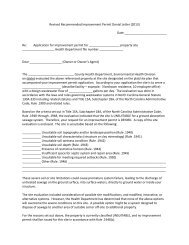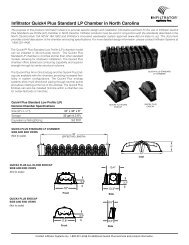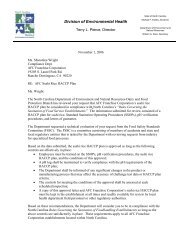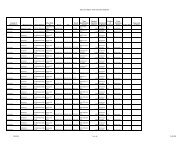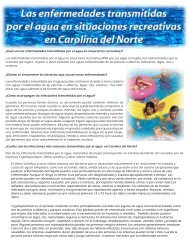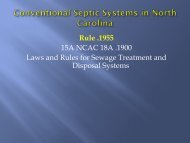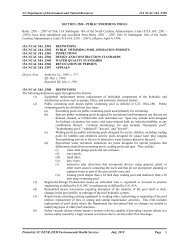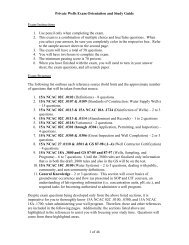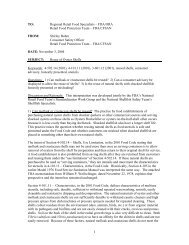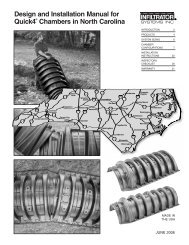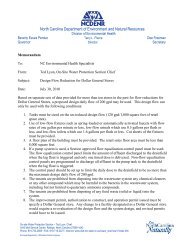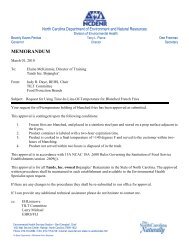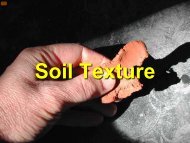Secondary Methods of Entrapment Prevention
Secondary Methods of Entrapment Prevention
Secondary Methods of Entrapment Prevention
You also want an ePaper? Increase the reach of your titles
YUMPU automatically turns print PDFs into web optimized ePapers that Google loves.
<strong>Secondary</strong> <strong>Methods</strong> <strong>of</strong> Preventing Bather <strong>Entrapment</strong><br />
From June 18, 2008 U.S. Consumer Product Safety Commission<br />
Staff Interpretations <strong>of</strong> Section 1404<br />
Devices or Systems Designed to Prevent <strong>Entrapment</strong>:<br />
…each public pool and spa in the United States with a single main drain other than an<br />
unblockable drain shall be equipped, at a minimum, with 1 or more <strong>of</strong> the following<br />
devices or systems designed to prevent entrapment...<br />
CPSC Staff Interpretation: In addition to having a drain cover or other anti-entrapment<br />
device that complies with ASME/ASNI A112.19.8, public pools and spas with<br />
single main drains must have one <strong>of</strong> the following additional systems or devices.<br />
(I) SAFETY VACUUM RELEASE SYSTEM (SVRS) - A safety vacuum release system<br />
which ceases operation <strong>of</strong> the pump, reverses the circulation flow, or otherwise provides<br />
a vacuum release at a suction outlet when a blockage is detected, that has been tested by<br />
an independent third party and found to conform to ASME/ANSI standard A112.19.17 or<br />
ASTM standard F2387.4<br />
STATUTORY DEFINITION OF A SVRS: The term “safety vacuum release system”<br />
means a vacuum release system capable <strong>of</strong> providing vacuum release at a suction outlet<br />
caused by a high vacuum occurrence due to a suction outlet flow blockage.<br />
(II) SUCTION-LIMITING VENT SYSTEM - A suction-limiting vent system with a<br />
tamperresistant atmospheric opening.<br />
CPSC Staff interpretation: A suction-limiting vent system is also called an atmospheric<br />
vent. It is a pipe teed to the suction side <strong>of</strong> the circulation system on one end and<br />
open to the atmosphere on the opposite end. The pipe is normally full <strong>of</strong> water<br />
equal to the same height as the pool. When a blockage occurs at the main drain,<br />
air is introduced into the suction line thus causing the pump to lose prime and<br />
relieving the suction forces at the main drain (suction outlet).<br />
Conceptual Suction-Limiting Vent System to Relieve Main Drain Suction<br />
Currently there are no approved voluntary standards for suction-limiting vent<br />
systems; however, an ASTM International voluntary standards task group was<br />
formed in March 2004 and is currently developing minimum requirements for<br />
field-fabricated vent pipes. The performance <strong>of</strong> the vent, the ability to prevent<br />
obstructions from occurring within the vent, and a test procedure to assess<br />
performance are being addressed. The correct design and construction <strong>of</strong> the
suction-limiting vent system are important to the overall function and should be<br />
certified by a design pr<strong>of</strong>essional and inspected by a licensed inspector.<br />
(III) GRAVITY DRAINAGE SYSTEM - A gravity drainage system that utilizes a collector<br />
tank.<br />
CPSC Staff interpretation: A gravity drainage system utilizing a collector tank is a<br />
swimming pool/spa with a separate water storage vessel from which the pool<br />
circulation pump draws water. Water moves from the pool to the collector tank<br />
due to atmospheric pressure, gravity and the displacement <strong>of</strong> water by bathers<br />
which removes the need for direct suction at the pool. This type <strong>of</strong> system is also<br />
referred to as a reservoir, surge tank, or surge pit.<br />
Conceptual Gravity Drainage System – Direct Suction Removed from the Pool<br />
Currently there are no voluntary standards for gravity drainage systems or<br />
collector tank specifications.<br />
(IV) AUTOMATIC PUMP SHUT-OFF SYSTEM - An automatic pump shut-<strong>of</strong>f system.<br />
CPSC Staff interpretation: An automatic pump shut-<strong>of</strong>f system would be a device that<br />
could sense a drain blockage and shut <strong>of</strong>f the pump system. Some safety vacuum<br />
release systems may meet this definition.<br />
One pump motor manufacturer has developed a circuit board for its motors that<br />
monitors current to the motor and shuts the pump <strong>of</strong>f when a noticeable change in<br />
current occurs, possibly caused by an entrapped bather.<br />
The National Electrical Code (NEC) regulation number 680.40 has a requirement<br />
for an emergency stop switch for the pump to be located within 5 feet <strong>of</strong> a public<br />
spa in case <strong>of</strong> bather entrapment. However, this switch is manually operated and<br />
would require the presence <strong>of</strong> another person to activate the switch and therefore<br />
would not qualify as “an automatic pump shut-<strong>of</strong>f system” under this Act.<br />
Currently there are no voluntary standards for automatic pump shut-<strong>of</strong>f systems,<br />
though the current SVRS standards provide release and response time<br />
performance criteria.<br />
(V) DRAIN DISABLEMENT - A device or system that disables the drain.<br />
CPSC Staff interpretation: Staff is not aware <strong>of</strong> a product that meets this description that<br />
is currently on the market. In the past, companies have developed products that<br />
sealed the suction outlet or shut <strong>of</strong>f the pump when a cover is removed.<br />
Additional consideration can be given to physically removing the submerged<br />
suction outlet (drain) by filling the sump with concrete (effectively removing the<br />
suction outlet from the bottom <strong>of</strong> the pool) as long as another source(s) <strong>of</strong> water
for the suction side <strong>of</strong> the pump is(are) available, such as skimmers, re-plumbing<br />
the suction outlet into a return inlet (permanently reversing flow), or permanently<br />
disabling the suction outlet plumbing at the pump (removing the suction outlet<br />
connection to the pump) to remove the suction entrapment potential at the<br />
submerged outlet (drain).<br />
Currently there are no voluntary standards for disablement devices or instructions<br />
for filling or re-plumbing the suction outlet.<br />
(VI) OTHER SYSTEMS - Any other system determined by the Commission to be equally<br />
effective as, or better than, the systems described in subclauses (I) through (V) <strong>of</strong> this<br />
clause at preventing or eliminating the risk <strong>of</strong> injury or death associated with pool<br />
drainage systems.<br />
CPSC Staff interpretation: This will allow the development <strong>of</strong> future products.<br />
Currently, the Commission has not determined that any other system is equally<br />
effective as, or better than, the systems described in subclauses (I) through (V) <strong>of</strong><br />
this clause. Further, there are no voluntary standards for such other systems.




